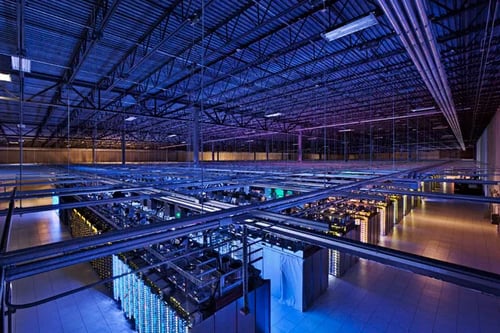Data Centers 101: Everything You Need to Know About “The Cloud”

A decade ago, if your boss told you that your “head was in the clouds” it probably meant you were goofing off on company time, but today we all have our heads in the clouds as businesses have migrated much of their workloads to “the cloud”.
What is “the cloud” or cloud computing? DatacenterHawk define the cloud as:
“A data storage and processing solution where the user utilizes virtual servers instead of physical servers. The virtual servers are supported by physical servers, often in multiple locations, but the physical servers combine to host the entire virtual ecosystem. Since the virtual ecosystem is shared by the physical servers, the user’s data isn’t tied to a specific physical location.”
The cloud is big business considering some of these eye-popping statistics from Amazon Web Services (AWS) , which an estimated three-quarters of enterprise cloud adoption in 2020:
- Public cloud computing market will be worth $800 billion by 2025.
- Enterprise cloud spending will make up 14 percent of IT revenue globally by 2024.
- Platform as a Service (PaaS) will grow by 26.6 percent by the end of this year.
- Some 70 percent of companies plan on using the cloud to increase tech budgets in the future.
- 61 percent of businesses have migrated their workloads to the cloud as of 2020.
Look Under the Ocean, Not Up in the Sky to Find the Cloud
While we live in an increasingly wireless world and Elon Musk seems to be launching more broadband internet satellites into the sky than fireflies on a Texas Hill Country summer evening, we really shouldn’t look up to find the cloud but look down.
“The reality is that the cloud is actually under the ocean,” wrote NYU professor Nicole Starosielski in The Conversation. Indeed, today’s high-speed, fiber optic internet is based on a vast network of underwater cables.
New cables are being laid each year as digital demand grows with some of the cables transmitting at speeds of 160 terabits per second or 16 million times the speed of today’s home internet connection.
Okay … So Why is it Called “The Cloud”?
So, if most of the work we do in the “the cloud” has more in common with fish than birds, why in the heck is it called “the cloud”? The cloud originated as a tech industry slang term before moving into mainstream acceptance. In the fast-moving days of the 1990s, with the internet and data center business booming into being in tandem, IT folks needed a way to diagram how networking infrastructure worked for their presentations.
called “the cloud”? The cloud originated as a tech industry slang term before moving into mainstream acceptance. In the fast-moving days of the 1990s, with the internet and data center business booming into being in tandem, IT folks needed a way to diagram how networking infrastructure worked for their presentations.
“Computer scientists and engineers needed some way in their diagrams and slideshows to refer to “the network,” that big grouping of computers and storage devices out there somewhere,” writes Tech Insider Matt Weinberger. “In other words, they needed some way to refer to something that was, essentially, somebody else’s problem. They settled on a cloud.”
Weinberger even traces the cloud-like imagery filed in patents in the 1990s:
- US Patent 5,485,455 (“Network having secure fast packet switching and guarantee quality of service”) originally filed in 1994 shows a misshapen circle in a diagram that could be called a cloud, though it looks more like the ghost Boo from Mario games.
- US Patent 5,790,548 (“Universal access multimedia data network”) originally filed in 1996 shows the metamorphosis with a diagram featuring a true-looking cumulus cloud.
From there it wasn’t much of a leap for people to refer to what was happening in that bubble or off-site sphere as happening in “the cloud”.
Weinberger reports that Compaq was using the cloud term in a document in 1996, but things were likely cemented a decade later when AWS launched its Elastic Compute Cloud (EC2) in 2006.
Skyrocketing Cloud Spending Stats: 2009-2020
Looking at historical data on enterprise spending on cloud and data centers and you can see the trend towards cloud infrastructure services is skyrocketing.
According to Statista, cloud infrastructure services accounted for just 2 percent of spending vs. data center hardware and software a decade ago but had surpassed traditional data center spending by last year with cloud infrastructure services at $129.5 billion vs. $89 billion for data center hardware and software.
That $89 billion for data center hardware and software was an actual decline from $93 billion two years earlier, while cloud infrastructure services almost doubled from 2018 from $69 billion.
Here is the year-by-year spending for the total category with the cloud infrastructure services share:
- 2009: $61.7 billion (Cloud $1 billion)
- 2010: $72.9 billion (Cloud $1.5 billion)
- 2011: $81 billion (Cloud $3.5 billion)
- 2012: $87.5 billion (Cloud $6.5 billion)
- 2013: $91 billion (Cloud $9.5 billion)
- 2014: $97 billion (Cloud $14 billion)
- 2015: $103 billion (Cloud $21 billion)
- 2016: $110.5 billion (Cloud $32 billion)
- 2017: $128 billion (Cloud $46.5 billion)
- 2018: $162 billion (Cloud $69 billion)
- 2019: $189.3 billion (Cloud $96 billion)
- 2020: $218.5 billion (Cloud $129.5 billion)
Different Types of “The Cloud”
Just as there are different types of clouds we see in the sky, there are different types of cloud deployments.
Cloudfare breaks “The Cloud” into the following categories:
- Private Cloud: Everything in a private cloud is dedicated to one organization or enterprise including servers, data centers and distributed network.
- Public Cloud: Multiple organizations are sharing in one or multiple data centers operated by an external vendor. In a public cloud, your company could even share space in the same server with others.
- Hybrid Cloud: In this deployment a combination of private and public clouds, and even on-premises legacy data center servers are used in combination.
- Multicloud: An approach where a company uses a combination of multiple public clouds from different external vendors.
Services that can be offered by cloud providers range from Software-as-a-Service (SaaS) to Platform-as-a-Service (PaaS) to Infrastructure-as-a-Service (IaaS) to Function-as-a-Service (FaaS).
Contact Data Center Systems today so that our team of technicians can help your enterprise implement an infrastructure design that meets structured cabling best practices.







